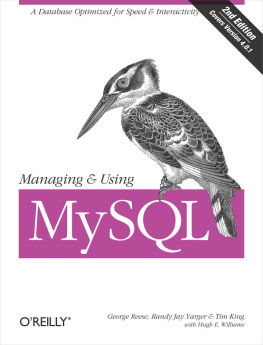Scott - PHP: MySQL & PHP Programming Guide: Web Development, Database & Hacking
Here you can read online Scott - PHP: MySQL & PHP Programming Guide: Web Development, Database & Hacking full text of the book (entire story) in english for free. Download pdf and epub, get meaning, cover and reviews about this ebook. year: 2015, genre: Home and family. Description of the work, (preface) as well as reviews are available. Best literature library LitArk.com created for fans of good reading and offers a wide selection of genres:
Romance novel
Science fiction
Adventure
Detective
Science
History
Home and family
Prose
Art
Politics
Computer
Non-fiction
Religion
Business
Children
Humor
Choose a favorite category and find really read worthwhile books. Enjoy immersion in the world of imagination, feel the emotions of the characters or learn something new for yourself, make an fascinating discovery.
- Book:PHP: MySQL & PHP Programming Guide: Web Development, Database & Hacking
- Author:
- Genre:
- Year:2015
- Rating:4 / 5
- Favourites:Add to favourites
- Your mark:
- 80
- 1
- 2
- 3
- 4
- 5
PHP: MySQL & PHP Programming Guide: Web Development, Database & Hacking: summary, description and annotation
We offer to read an annotation, description, summary or preface (depends on what the author of the book "PHP: MySQL & PHP Programming Guide: Web Development, Database & Hacking" wrote himself). If you haven't found the necessary information about the book — write in the comments, we will try to find it.
PHP: MySQL & PHP Programming Guide: Web Development, Database & Hacking — read online for free the complete book (whole text) full work
Below is the text of the book, divided by pages. System saving the place of the last page read, allows you to conveniently read the book "PHP: MySQL & PHP Programming Guide: Web Development, Database & Hacking" online for free, without having to search again every time where you left off. Put a bookmark, and you can go to the page where you finished reading at any time.
Font size:
Interval:
Bookmark:
PHP:
PHP & MySQL Programming Guide for Web Programmers and Hackers
Table of Contents
Introduction
Chapter 1: Introduction to MySQL
Chapter 2: Connecting to MySQL Database Using PHP
Writing PHP
Declaring PHP
Opening and closing a connection
Chapter 3: Creating Database and Tables in MySQL Using PHP
Creating a MySQL table using PHP:
What are data types?
Inserting data into a MySQL table using PHP
Chapter 4: Displaying and Manipulating Data from MySQL Database Using PHP:
Displaying data from MySQL Database using PHP
Chapter 5: Hacking a Website Using SQL and PHP Scripting
What is SQL Injection?
Conclusion:
Copyright 2015 - All rights reserved.
In no way is it legal to reproduce, duplicate, or transmit any part of this document in either electronic means or in printed format. Recording of this publication is strictly prohibited and any storage of this document is not allowed unless with written permission from the publisher. All rights reserved.
The information provided herein is stated to be truthful and consistent, in that any liability, in terms of inattention or otherwise, by any usage or abuse of any policies, processes, or directions contained within is the solitary and utter responsibility of the recipient reader. Under no circumstances will any legal responsibility or blame be held against the publisher for any reparation, damages, or monetary loss due to the information herein, either directly or indirectly.
Respective authors own all copyrights not held by the publisher.
Legal Notice:
This book is copyright protected. This is only for personal use. You cannot amend, distribute, sell, use, quote or paraphrase any part or the content within this book without the consent of the author or copyright owner. Legal action will be pursued if this is breached.
Disclaimer Notice:
Please note the information contained within this document is for educational and entertainment purposes only. Every attempt has been made to provide accurate, up to date and reliable complete information. No warranties of any kind are expressed or implied. Readers acknowledge that the author is not engaging in the rendering of legal, financial, medical or professional advice.
There are various scripting languages that are used for developing websites and the most used scripting language is PHP. It is highly popular among the developers as it provides additional functionalities that are present which are not available in other scripting languages. It is also called as the general purpose language used for scripting. It is an open source script which means the scripting code is available for the developers to see without any payment required. Initially when PHP was introduced, its abbreviation was Personal home page. But later it's been changed to hypertext pre-processor.
Scripting languages are the languages that are used and written for the run time operations. These scripts are only interpreted but not compiled. These scripting languages are used in software applications and embedded systems.
A website is in the front end which has to be tied up with a strong back end which will give a complete product. For this usage of My SQL will be beneficiary. My SQL relates to a database that depends on the relationships between the tables that are present in that database. These relationships will increases the reliability of the database and also the speed of the retrieval of the data. The combination of these will definitely take the web application to a new level. These help in creating high interactive web pages that will be highly useful for the users. This also is an easy combination to use not just by users but also the developers.
There are many packages such as Ruby, Drupal, Wordpress, etc. that use my SQL to create dynamic web pages. Dynamic web pages means that the pages output depends on the data users give.
PHP can perform mathematical and Boolean operations easily. PHP strikes a perfect balance for both beginners and advanced coders as it is simple the beginners will have easy way to work with it and for advanced coders it will provide various high end functionalities that they can try out in different ways.
MySQL is also an open source database that is dependent on the relationships between those tables. Hence it is called a Relational Database and managing it is Relational Database Management System and it is one of the most popularly used RDBMS after Oracle.
Like PHP MySQL has its own important characteristics listing a couple of them:
- Architectural Design : MySQL has a client/server architecture that contains the MySQL server that acts a medium to which the client and server interact with. This interaction can be with multiple clients. A client could be an application that has connected with the server for retrieving data. These could be distributed over multiple computers or can be from the same computer i.e. the client and the server can be working from the same computer or they can be from different computers spit over the borders. High access of the server can be provided for various clients to access.
- High Speed : Since most of the tables in the database are connected with the correct joins the data can be retrieved quite fast. And this is the most important feature of MySQL that makes it so popular.
- Independent of the platform : Like PHP even MySQL server can run on multiple operating systems such as Linux, MAC, UNIX, windows etc.
- High compatibility of SQL and MySQL : SQL stands for Structured Query Language. It is a programming language which MySQL database supports. Through Structured Query Language we can create databases i.e. create the tables in the database, create their relationships and also the data and using the same language we can manipulate the data. Using the same for structured query language we can also write statements that are called as queries that can be used to retrieve the data. So since the same language can be used for everything it becomes easy the learner to just learn this one language and manipulate the whole system easily.
- Supports Open Database Connectivity aka (ODBC ): MySQL through Database Connectivity (ODBC) provides the connection of its database to be used by the programming language that the operating system of that computer uses.
- Existence of two dimensional data : There are many systems such as geographic information system that use this mySQL as it supports two - dimensional data.
- Use of multiple APIs : API stands for Application Program Interfaces. MySQL can be developed using many of the APIs individually which gives the developers high flexibility. Few of such Application Program Interfaces are C, Java, CPP, Perl, PHP, Python etc. which can also be the client side program.
PHP and MySQL are highly independent languages that can be combined for various and amazing outputs. This is mostly done by the web developers. In all the web applications there are two parts that the web developer needs to take care of the user interface or also known as the front end and the database part which is also known as the back end. So it is highly clear by now that which plays the role where.
So, PHP will help the developer to develop the front end and the backend can be developed using mySQL. There are many programs that can be written to do tasks using PHP. PHP helps the web developer a lot as it is highly flexible. By flexible it means that using coding of PHP the developer can display the web page as the simplest task and also check the data that the user is entering via the HTML form.
These checks can be of high value as they will filter all the unnecessary data that will in turn help in the performance of the database which is related to the application. This gives the application developer undue advantage. MySQL with PHP can also perform easy and complicated data manipulations via a high end web page which is easy to build, easy to access and easy to use.
Font size:
Interval:
Bookmark:
Similar books «PHP: MySQL & PHP Programming Guide: Web Development, Database & Hacking»
Look at similar books to PHP: MySQL & PHP Programming Guide: Web Development, Database & Hacking. We have selected literature similar in name and meaning in the hope of providing readers with more options to find new, interesting, not yet read works.
Discussion, reviews of the book PHP: MySQL & PHP Programming Guide: Web Development, Database & Hacking and just readers' own opinions. Leave your comments, write what you think about the work, its meaning or the main characters. Specify what exactly you liked and what you didn't like, and why you think so.

















